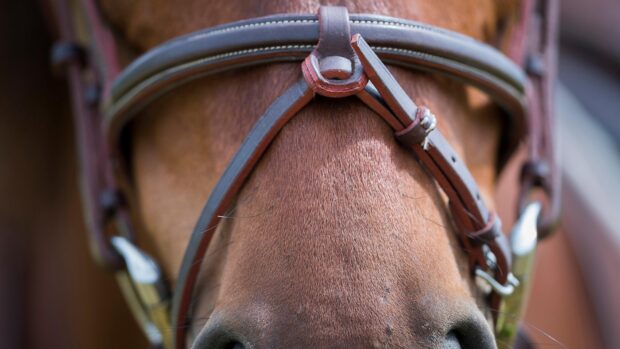Cavesson
The cavesson noseband is the simplest form of all nosebands and gives a “finished” look to a horse’s head.
It should be fitted so that it comes just below the horse’s facial bones and so that you can slip one or two fingers between the strap which goes across the nose and the horse’s face.
This and the cinchback cavesson are the only nosebands which should be used with a double bridle, to avoid conflicting actions of bits, curb chain and noseband.
Drop
This noseband often works well on horses who put their heads in the air and open their mouths to pull, as the low pressure point encourages them to drop their heads.
The front part should lie just on the nasal bones, not on the soft part of the muzzle. If it is too low, it will restrict the horse’s breathing.
If your horse is difficult to fit with a standard drop that adjusts only at the back, ask your saddler to make one which adjusts across the front.
Never attach a standing martingale to a drop or any other noseband fastening below the bit, as you’ll restrict the horse’s breathing.
Flash
The Flash has a less directaction than a drop, which may be why some horses prefer it. The front part is adjusted as a cavesson and must be substantial – thin, flimsy nosebands slip down the horse’s face.
A standing martingale can be attached to the upper part of a flash, unlike a drop noseband.
The flash can help keep the bit central in the horse’s mouth, making it popular with some dressage trainers, who use it when a horse is ridden in a loose-ring snaffle.
Grakle
Also called the crossover orfigure of eight noseband, the grakle is popular with event riders.
The noseband was originally designed for, and is named after, the hard-pulling winner of the 1938 Grand National.
The standard Grakle fits below the cheekbones and is supposed to prevent the horse crossing his jaw. If the horse tries to open his mouth he will feel pressure on the chin groove and on the bridge of the nose.
The main drawback with the standard Grakle is it tends to slip down, whereas the high ring Grakle stays in place.
Double back
Also known as the clinchback noseband, this doubles back on itself and can be fastened tighter than an ordinary cavesson without the risk of the buckle digging into the jaw.
Some show and dressage riders use this noseband with double bridles on horses who cross their jaw. Care should be taken not to over tighten it.
The double back noseband does give a little extra control, and some horses resent it less than a tight nosebands which fasten below the bit.
Kineton
Also known as the Puckle noseband, it comprises a strap across the front of the nose with a metal U-shaped loop at each end.
These metal loops slot under and inside the bit rings and strong pressure can be applied on the nose when the rider takes up the reins.
A Worcester noseband tends to be a kinder and more effective alternative.
Worcester
The Worcester noseband was developed and has been patented by Shires Equestrian.
The broad cavesson part of this noseband has two narrow straps at the centre front, which fasten to the bit rings.
It was originally designed for strong horses, as it adds nose pressure to the rein aids. It also limits the backwards movement of the bit. Some riders havefound that it also helps with steering.
Australian cheeker
A favourite with racehorse trainers, this is basically a pair of rubber bitguards joined by a central strap passing down the face and fastening to the bridle headpiece.
It’s said to have a psychological effect on pullers – the theory is that the horse can see, and backs off from, the central strap.
It also helps dissuade horses who try to put their tongue over the bit, as it prevents a jointed mouthpiece dropping too low.



